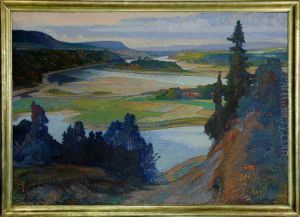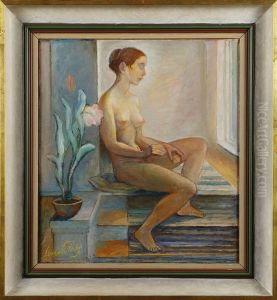Simon Gate Jonsson Paintings
Simon Gate Jonsson, born in 1883 in the town of Transjö, Sweden, was a pivotal figure in the development of Swedish glass art and design. His journey into the art world began with his studies at the Technical School in Stockholm, where he honed his skills in drawing and painting. However, it was his collaboration with the Orrefors Glassworks, starting in 1916, that marked the beginning of a revolutionary era in glassmaking, not only in Sweden but globally. Gate, alongside his colleague and fellow artist Edward Hald, played a crucial role in transforming Orrefors into a renowned name in the realm of glass artistry.
Gate's contributions to glass design were characterized by a blend of technical innovation and artistic expression. He was instrumental in developing the 'Graal' glass technique in the early 20th century. This technique, which involved encasing colored and patterned glass layers within clear glass, allowed for intricate and detailed designs that had not been seen before. Gate's mastery of this method led to the creation of stunning pieces that combined the visual depth of painting with the luminous quality of glass. His works often featured natural motifs and were celebrated for their exquisite beauty and craftsmanship.
Throughout the 1920s and 1930s, Gate's reputation continued to grow, both in Sweden and internationally. He was a regular participant in major exhibitions, such as the Paris Exposition des Arts Décoratifs in 1925, where the distinctive qualities of Swedish glass were showcased to the world. His designs, characterized by elegance and a meticulous attention to detail, were highly sought after by collectors and connoisseurs.
Simon Gate's legacy extends beyond his individual creations. He was a mentor to younger artists and craftsmen, imparting his knowledge and passion for glassmaking. His influence helped establish Sweden as a center of excellence in glass art, a reputation that endures to this day. Gate's work is represented in numerous museum collections worldwide, including the Nationalmuseum in Stockholm and the Victoria and Albert Museum in London. He passed away in 1945, but his vision and artistry continue to inspire generations of glassmakers and artists.

